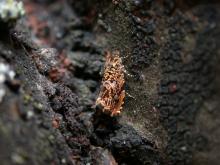Enarmonia formosana
Pest description and crop damage The cherry bark tortrix (CBT) damages many woody ornamental trees and shrubs in the family Rosaceae. In the PNW, this invasive moth occurs in urban settings in lowland coastal valleys in British Columbia and Washington between the west slope of the Cascades and Puget Sound south to Portland. So far, it has not affected commercial fruit production regions. Oregon Department of Agriculture quarantine [603-052-0450] requires permits or certifications for importation of fruit tree nursery stock from British Columbia, Washington state, and Multnomah and Clackamas counties. Hosts for this pest include Prunus (cherry, plum, and peach), but also Malus (apple, crabapple), Pyrus (pear), Crataegus (hawthorn), Sorbus (mountain ash), Cydonia (quince), Pyracantha (firethorn), and Photinia. The quarantine also covers firewood from these trees.
Larvae are 0.3 to 0.4 inch long, pale gray to flesh-colored, with small, pale gray spines scattered on the surface and a yellowish-brown head. Larvae feed directly on the cambial tissues of the tree and may kill the tree in sufficient numbers. Otherwise, their feeding activity decreases the supply of nutrients to the tree and increases susceptibility to disease or insect attack and environmental stress, including cold injury. The first indication of attack is the exuding of a gum-like resin often mixed with fecal pellets and silk. The trunk and larger limbs of bearing fruit trees are affected, usually at pruning wounds.
Biology and life history Larvae overwinter under bark. During spring, they resume feeding and eventually pupate in a silken tube that protrudes beyond the bark surface of the feeding site. In Europe, pupation takes place from April until late August and lasts about two weeks. Adults fly from late April to September and are most active in the early morning; some may be attracted to lights at night.
Eggs are laid on tree bark, in crevices, or under loose bark, primarily at wounds (mechanical or old infestations). Eggs are placed singly or in overlapping groups of two or three and hatch in two to three weeks. Hatching larvae penetrate the bark through openings (natural and mechanical wounds) and feed on the living tissue of the tree's bark. Graft unions of ornamental trees are preferred sites for attack. Larvae do not penetrate the hardwood of the tree.
During feeding, larvae construct a frass tube consisting of fecal pellets and webbing. The tubes are about 0.25 inch long and look soft, as if they are made out of sawdust. They most often are found around the base of the trunk or where a branch and trunk meet. The frass tube is the location for pupation.
Scouting and thresholds Frass tubes protruding from bark are an excellent indication of CBT infestations, and susceptible trees should be monitored regularly. Because other insects can cause similar damage, inspection of the larvae is required for confirmation.
Management-biological control
Parasitoid wasps target the eggs, larvae, and pupae. Eggs that turn black indicate parasitism (likely by Trichogramma spp. wasps) and should not be disturbed.
Management-cultural control
Avoid unnecessary pruning cuts or injuries to the tree during the summer flight period. Like most wood-boring insects, this pest is attracted to stressed trees. Keep trees as healthy as possible with appropriate watering, fertilizer applications, and pruning. Reduce humidity around trunks by avoiding irrigation splash and control weeds and grass. Remove heavily infested branches or trees. Use pheromone traps to monitor male moth populations.
Management-chemical control: HOME USE
There are no products registered for control of this pest. Management activity should be concentrated in fall when biological controls have had a chance to act and larvae are still actively feeding and can be targeted.
Management-chemical control: COMMERCIAL USE
There are no products registered for control of this pest in commercial apple orchards because the pest, so far, has not been a significant issue in commercial orchards.



